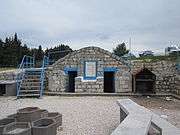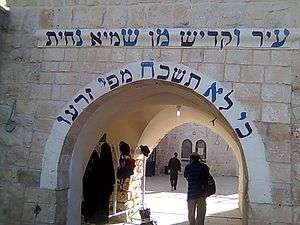Idra
The Idra, which means threshing floor in Aramaic, is a Kabbalistic work included in printings of the Zohar, and was probably written and appended to the main body of the Zohar at a later date. Contemporary scholars believe the Idra dates to the third generation of Zoharic literature, which produced also the Tikunei haZohar, the Ra'aya Meheimna, and other Zoharic material. The main body of the Zohar, or guf ha-zohar, dates to the second generation of Zoharic material.


There are actually two texts in Zoharic literature called Idra: the first being the Idra Rabba, or "greater Idra", and the second being the Idra Zuta, or "lesser Idra", with these two texts being intimately connected to each other.
The story of the Idroth is as follows:
- Idra Rabba (Zohar 3:127b-145a): R. Shimon bar Yohai convenes with nine other scholars, and they gather in the sacred אִדְרָא, or threshing field, where they thresh out secrets.[1] Each scholar expounds various configurations of the partsufim, and three of them die in ecstasy while doing so.
- Idra Zuta (Zohar 3:287b-296d): Years later, at RASHB"I's deathbed, the seven still-living scholars come to his deathbed, along with the whole heavenly host. He alone explains the configurations of the partsufim, so this work is more unified. RASHB"I wavers between this world and the next. He directed his students to celebrate his passing that day as a Yom Hillula (wedding),[2] as it would Messianically unite the immanent and transcendent Divine Lights of Creation. The Idra Zuta is considered the deepest teachings of the Zohar.[3]
In the standard printed edition of the Zohar, the Idra Rabba is printed in Naso, and the Idra Zuta is printed in Ha'azinu.
Lurianic systemisation of the Partzufim
16th century Lurianic Kabbalah systemised the Zoharic Partzufim in its recasting of the whole Kabbalistic scheme. On one occasion, as recorded by Chaim Vital, Isaac Luria convened his students in the traditional location of the Idra Rabba Assembly near Meron, placing each one in the designated location of their former incarnations as the students of RASHB"I. In so doing, he identified himself with Shimon Bar Yohai.[4]
See also
References
- Vital ShG, Haqdamah 38, pp. 132-133. "I once traveled with my master, may his memory be blessed, to the place where Rabbi Shimon bar Yohai's disciples assembled when they held the Idra Rabba [described in portion] Naso [in the Zohar]. There on the eastern side of the road, there is a cave (lit. "great rock") in which there are two large openings. In the opening on the northern end was the place where Rabbi Shimon bar Yohai, peace be upon him, sat on the occasion of the Idra."
- Zohar 3:291a
- Rectifying the State of Israel, Yitzchak Ginsburgh, Gal Einai. P. 136
- Fine 2003, pp. 300
Bibliography
- William Oscar Emil Oesterley, George Herbert Box (1920). A Short Survey of the Literature of Rabbinical and Mediæval Judaism. Macmillan. p. 248.
Idra Rabba.
- Vital, Hayyim; Isaac Luria (2003) [Late 1500s/Early 1600s]. Shaar ha-Gilgulim [Gates of Reincarnation]. Thirty Seven Books Publishing. p. 534. ISBN 0-9727924-0-6. Archived from the original on 2013-12-12. Retrieved 2010-08-16.
- Fine, Lawrence (2003). Rodrigue, Aron; Zipperstein, Steven J (eds.). Physician of the Soul, Healer of the Cosmos: Isaac Luria and His Kabbalistic Fellowship. Stanford, CA: Stanford University Press. p. 480. ISBN 0-8047-4826-8. Retrieved 2010-08-16.